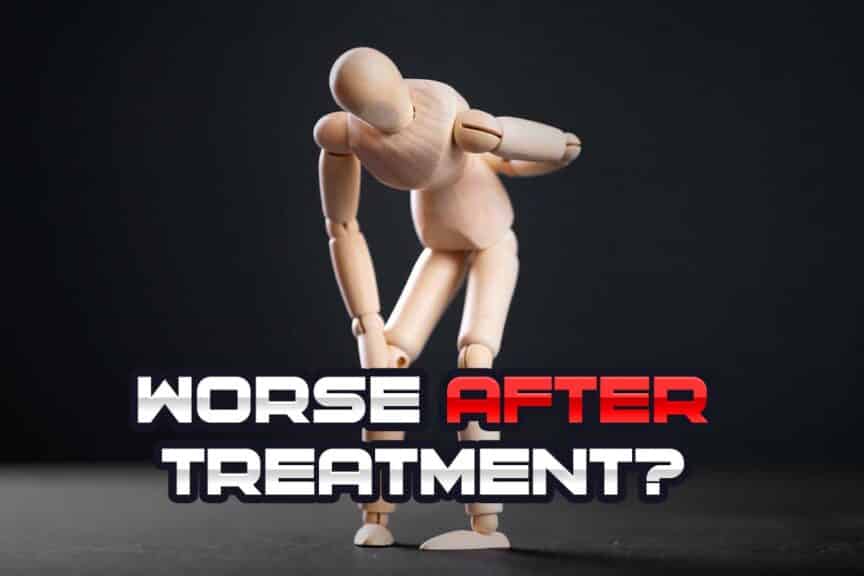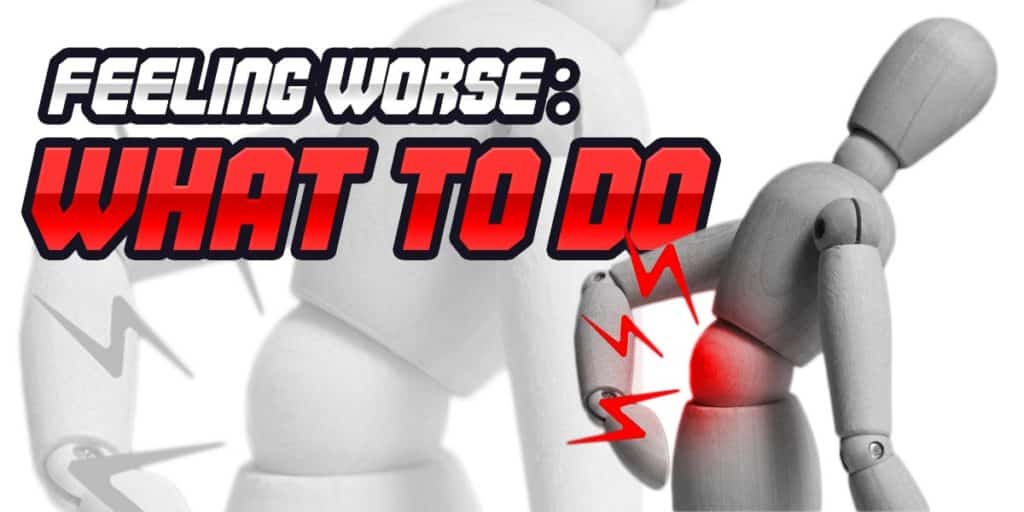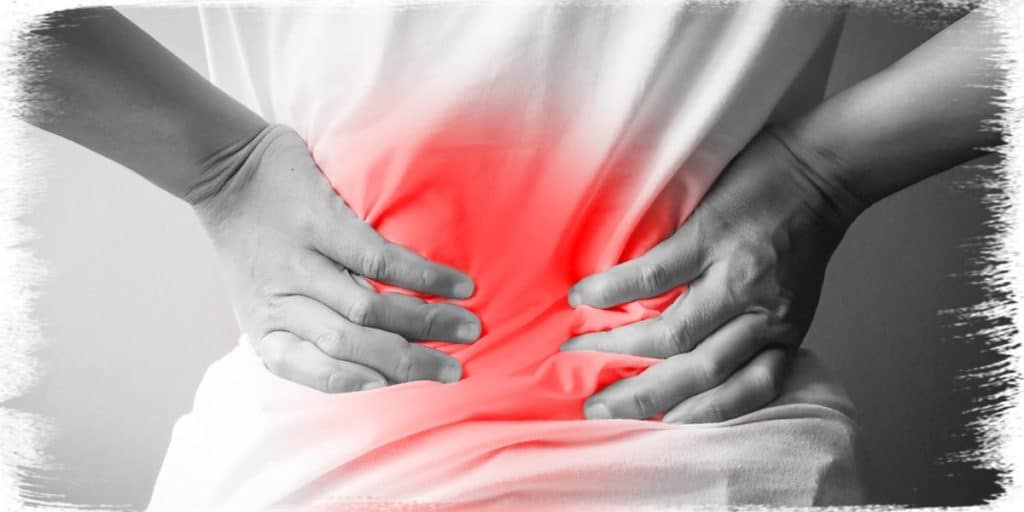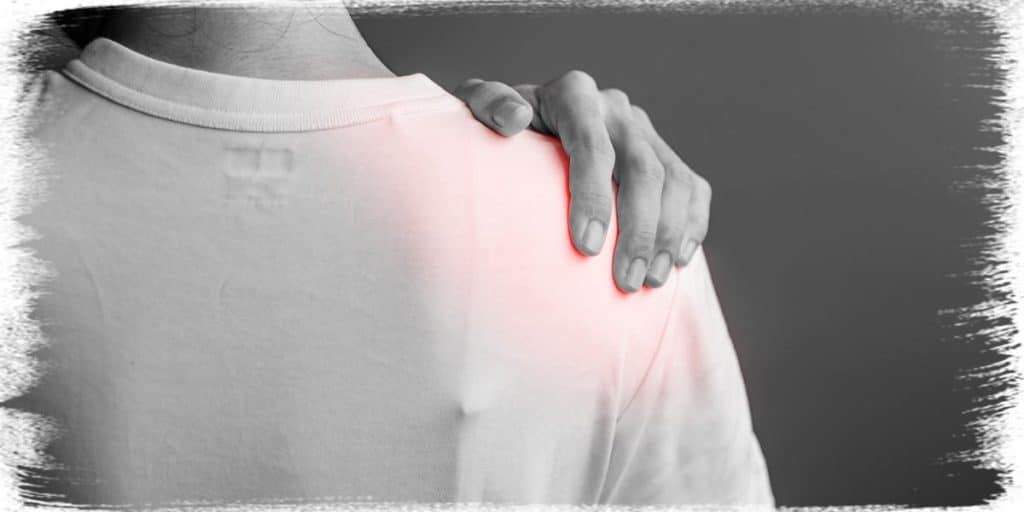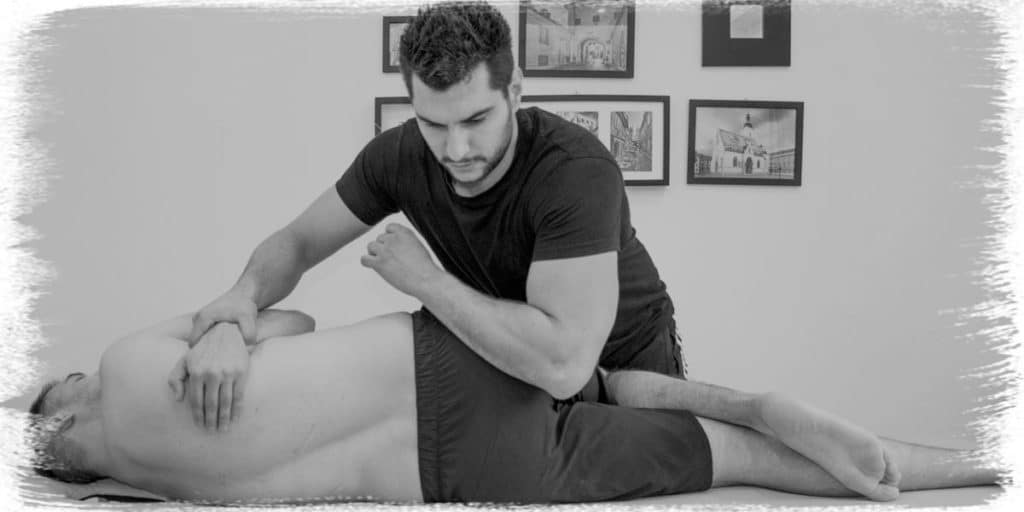If you just recently had a physical therapy session and feel like you now have more soreness or discomfort than before the session began, know that you’re not the only one it happens to; post-treatment discomfort happens to a lot of individuals and for a variety of different reasons.
This article will walk you through the basics of understanding why individuals sometimes feel less-than-ideal after a treatment session and the various steps you can take to hopefully reduce any post-treatment discomfort you may be experiencing.
Understanding why you may feel soreness or discomfort after a physical therapy session can help ease anxiety and help you take appropriate action to thereafter feel better. If your discomfort is excessive, you should call your physical therapist and speak with them directly for further insight.
There’s some critical information to unpack here, but doing so will help you understand what’s to be expected and tolerated when it comes to how you feel after a treatment — and what’s not. So, let’s dive into it!
ARTICLE OVERVIEW (QUICK LINKS)
Click/tap on any of the headlines below to instantly jump to that section of the article
• Not all hurt means harm
• Expected types of discomfort
• Expected amounts of discomfort
• Acceptable timelines for discomfort
• Different types of treatment
• How to: Decreasing discomfort
• When to call your physical therapist
Related article: Pro Advice: Find the Best Physical Therapist for You with THESE Tips
Disclaimer: While I am a physical therapist, I am not YOUR physical therapist. As a result, I cannot tell you whether or not any treatments or training methodologies mentioned on this website or in this article may or may not be appropriate for you, including information pertaining to post-treatment discomfort. By following any information within this post, you are doing so at your own risk. You are advised to seek appropriate medical advice for any pain you may be experiencing.
Please keep in mind that the nature of this article is very generalized; pain can be very complex, and there are a near-infinite number of factors that determine the appropriateness of an individual’s pain and discomfort after a physical therapy session. What follows is meant to be a quite generalized overview of expectations of how one should feel and what to expect after an orthopedic-based physical therapy session.
As well, this article is aimed at “feeling worse” in terms of physical discomfort. Sometimes symptoms that aren’t associated with physical discomfort can also worsen (such as paresthesia into an extremity). However, this article won’t cover these types of worsening (but non-painful) symptoms.
Not all hurt means harm
Pain and discomfort can undoubtedly be an unsettling or even frightening occurrence, and it can often be discouraging if you feel that a treatment session from a physical therapist has made it more prominent. However, for certain conditions, it’s actually an appropriate response (but not always, mind you). Being aware of this is a critical component to your treatment and recovery.
Not all pain or discomfort is inherently bad; for many circumstances, such as when dealing with low back pain, it can signify that positive change is taking place within the body.1–4 The scientific literature shows that patients who understand the nature of their pain and their condition tend to have better recovery outcomes than those who don’t.5–8
Why is post-treatment soreness sometimes necessary?
In short, improving the health of tissues within the body (such as muscles and tendons, among others) for better mobility, strength, etc., frequently involves challenging and stimulating these tissues in ways that they’re not used to being challenged.
When these tissues and structures are challenged beyond what they are used to, they can become sore, mildly irritated or sensitive — grumpy, if you will, for a short duration of time afterward. Sometimes we refer to this as “stirring the pot” or “poking the bear.”
As a physical therapist, I often term this relatively short period of post-treatment discomfort the “physical therapy hangover” since its unpleasant nature is similar to the short-lived but annoying phenomenon of being hungover the day after a “drinking session.” Many times, it’s a “necessary evil” that needs to take place to stimulate and augment the tissue recovery process. But to be sure, it should never be excessive – just mild at most.
In a very simplistic sense, when a tissue (such as a muscle or tendon) becomes sore after a treatment session, it’s a signal to the body that this structure wasn’t strong enough or healthy enough to tolerate the treatment work that was just performed on the area. The body then mounts a response to begin a healing or strengthening process to that particular area, but it may not mount that response if it wasn’t challenged enough to realize that it needs to improve in some capacity.
This is the same phenomenon that occurs when you workout and improve your overall physical fitness; lifting weights with appropriate resistance lets your muscles, tendons and bones know that they need to adapt by getting a bit stronger. The muscle soreness that you can experience after a workout is actually a signal that your body is improving its overall strength and physical capacity.
That being said, it’s vital to know what types and amounts of discomfort are appropriate (and what aren’t), so let’s look at the next section for more information.
Expected types of discomfort
As a general rule, when it comes to discomfort arising from an orthopedic-based treatment (a treatment directed at your joints, muscles, tendons or ligaments), it’s expected that you may feel sensations of aching or dull sensations of discomfort over the generalized area that was treated.
This type of discomfort is often referred to as myalgic pain (pain arising from a muscle) or somatic pain (pain arising from the pain receptors in the skin, muscles, joints, tendons and bones).
Discomfort that is typically less ideal
Again, as a general rule, we tend to want to stay away from elevated post-treatment pain sensations that are sharper, stabbing, radiating or burning-like in nature, and we don’t want these feelings to be any more intense than before your session. Mind you, this might not always be the case, and I can’t tell you if this specifically applies to you and your condition/injury since I am not your physical therapist and didn’t perform your treatment session.
But generally speaking, if your physical therapy treatment was aimed at improving the overall health and movement of your muscles, tendons or joints, having elevated levels of sharp, stabbing or burning discomfort isn’t an expected response. These types of discomfort tend to signify that that pain is arising from irritated tissues such as nerves or joints.
If you do feel a rather notable increase in this type of discomfort following a treatment session, it should only be for a very brief period of time, perhaps nothing more than a few hours at max. If you experience highly elevated and prolonged levels of this discomfort after treatment, it may be worth contacting your physical therapist for further instruction.
Expected amounts of discomfort
Like many others circumstances involving the human body, the principle of “more is not always better” is certainly at play with this scenario.
As a sort-of analogy: doing an arm workout and experiencing a mild muscle soreness for the next day is perfectly acceptable; working out so much that you’re in agony for the next four days and can’t lift your arms above your head isn’t.
The same goes for soreness after a physical therapy session – being mildly (and sometimes moderately) sore for the next day after your session is likely beneficial and an overall good signal that your body can respond appropriately.
Many clinicians, including myself, often let our patients know (depending on their condition and the treatment provided) that if discomfort is elevated by no more than 2 points (on a 10-point scale), it’s acceptable (provided their pre-treatment pain was only mild).
For example, if a patient rated their pre-treatment pain as a 3 out of 10 (10 = worst pain ever experienced), a post-treatment pain of no greater than a 5 is acceptable (provided it only lasts for an appropriate amount of time – discussed below).
Pro tip: The healthier your tissues and body parts become, the less likely you’ll have elevated levels of post-treatment soreness. Many times, the first one or two treatment sessions often produce the greatest discomfort since this is the point in time when the tissues and subsequent body parts are at their least healthy state; the more unhealthy a tissue or structure is, the more sensitive it tends to be to treatment.
Acceptable timelines for discomfort
The acceptable timeline for elevated discomfort levels following a physical therapy treatment session can depend on numerous factors, such as the specific condition or injury being treated, the extent of the injury, and the phase of recovery that the tissues or body part are currently undergoing.
With that being said, the general rule is that elevated levels of discomfort (i.e. discomfort greater than before the session began) shouldn’t last for more than 24 hours.
If you’re past the 24-hour mark and things haven’t gotten any better, it doesn’t necessarily mean that any damage or harm has taken place; rather that a bit more work or treatment intensity was done to the area than what might have been needed.
If you’ve just had your very first treatment session, take comfort in knowing that post-treatment discomfort is often greatest with the first one or two sessions. There are two primary reasons for this:
- This is when your injury or condition is the most sensitive to treatment since the tissues are still either newly injured (meaning they’re currently quite unhealthy) and/or aren’t yet used to receiving therapeutic treatment. Either of which can significantly impact the sensitivity of these tissues during and after a treatment session.
- The first treatment session is often the most challenging for your therapist to determine the amount and intensity of treatment to provide. We do our best to provide an amount of treatment that is effective (we want to help you get out of pain as quickly and safely as possible) but without overshooting the mark. Sometimes, (for various reasons) the therapeutic dose that we deliver might be more than what the targeted tissues or body part was willing to tolerate.
As a physical therapist, I (and any other therapist) can assure you that humans are incredibly diverse; it may take us a session or two to really dial into how your body or condition responds to treatment. Oftentimes two individuals with an identical injury or condition will produce vastly different responses to treatment in terms of post-treatment pain or discomfort.
If you deem your post-treatment soreness to be excessive either in amount or in duration of time, let your physical therapist know during your next session — we want to make sure we modify or change our treatment plan as needed to help ensure that you’re more confident and comfortable moving forward in your treatment. There are usually plenty of different treatment techniques or modifications to approaches that we can use to help ensure your discomfort isn’t elevated or prolonged more than necessary for future treatments.
Different types of treatment
Since different types of treatment can have expected types (and amounts) of discomfort, it’s worth going over some more common types of treatments performed in physical therapy clinics and how the body usually responds as a result.
Perhaps the most important factor to understand here is that an increase in discomfort is permissible, however, an increase in pain isn’t. There can be some semantics at play here in terms of what the difference between the two is, so let’s word it like this:
Discomfort: A physical sense of soreness or aching that is noticeable but otherwise tolerable with daily movements and activities.
Pain: A physical sensation that is seemingly intolerable and produces a sensation of suffering as a result.
Manual therapy treatment
Manual therapy is a form of treatment that involves using hands-on techniques to help optimize the movement or function of a particular body part or region. This can range from massage-based techniques to joint mobilizations, manipulations, specific types of stretches or any combination of such techniques.
Depending on the intensity of the treatment and the current overall status of the areas that were treated, soreness is common, especially when the body experiences this treatment for the first time; as tissues become healthier, subsequent manual therapy treatment sessions of the same style and intensity should produce less and less discomfort.
Therapeutic modality treatment
Therapeutic modalities are specialized pieces of equipment that physical therapists may choose to use as part of your treatment session and overall rehabilitation, depending on various factors of your overall injury or condition.
These can include modalities such as:
- Electrotherapeutic modalities such as TENS and NMES devices
- Acoustic waveform devices such as ultrasound and shockwave therapy
- Thermal modalities such as hot packs and ice packs
Some of these devices can produce sensations of fatigue or mild discomfort either during or after a treatment session, based on the volume and intensity of the modality treatment and the intended usage of the device.
Regardless of the device utilized, again, under normal circumstances, you should only experience mild-to-moderate discomfort, but not pain.
Exercise-based treatment
Exercise-based treatment aims to help improve strength, endurance, or overall movement (such as range of motion) using exercise. Due to the intent of this type of treatment involving physical challenge to muscles, joints, tendons, etc., it’s not uncommon for the areas that were exercised to experience an onset of mild-to-moderate soreness or discomfort that begins anywhere from twelve to forty-eight hours after the treatment session, which is sometimes referred to as delayed onset muscle soreness (DOMS).
This soreness can last upwards of a couple of days if the exercise or exercises were performed at a high or demanding intensity or if the tissues were relatively unhealthy or deconditioned.
Intramuscular stimulation (IMS) treatment
I have an entire article that goes into more extensive detail than what I’ll cover in this section, so if you want more insight, check out my article: How to Reduce Soreness After Dry Needling: Five Proven Tips
Intramuscular stimulation (also known as dry needling) can produce noticeable levels of soreness or discomfort in muscles that can last upwards of a couple of days, based on factors including how much IMS was performed to the muscle(s), the twitch responses that were elicited and the current overall state of the muscle(s) prior to the needling.
Soreness following IMS/dry needling treatment is quite common and expected, especially if the muscle was tight or irritable prior to being needled.
How to: Decreasing discomfort
If you’re finding that the discomfort you’re experiencing after your treatment is quite a nuisance and that you need to try and get it under control a bit more, some of the following tips may be of benefit, depending on the nature of your condition or injury.
Please remember: these are rather generalized strategies; you may need to modify them or forego them altogether if they don’t feel beneficial for you.
Aching muscles and joints
If your physical therapy treatment involved treating tight or aching muscles or joints, you may find that gentle heating of the area that is now sore or feeling worse can help take the edge off. Often, a heating pad or similar heating device over the treated area can help reduce sensations of stiffness and soreness. Heat does a relatively good job at improving blood flow to the area, distracting your brain from sensations of pain (attributed to the gate pain control theory) and improving ranges of motion to muscles and joints.
Heating the area for approximately twenty minutes can heat up tissues up to 2cm deep. And so long as you’re using adequate insulation between the heating device and your skin (so that your skin doesn’t burn), you can likely heat the area multiple times per day.
Related article: Physical Therapy Exercises: Here’s How to Stick to Them for Success
Generalized pain and discomfort
If your pain is quite generalized and you’re not sure whether or not it may be arising from muscles and joints, there are a couple of strategies that may be worth implementing as a means to help control and reduce your pain:
Deep breathing exercises:
It may not sound like the most exciting thing to do, however, deep breathing exercises have been found to reduce pain levels in those experiencing various extents of pain.9,10 These types of pain-control or pain-reduction strategies are often termed “taking a pain pill,” where the pain can be knocked down by a perceptible extent.
What’s even better is that deep breathing can be done anywhere at any time, making it highly practical and accessible to pretty much anyone. Check out these articles for more information on how these exercises work and how they can be performed:
- Relaxation & Pain Management: The relaxation response can play a role in managing chronic and acute pain
- Can slow deep breathing reduce pain? An experimental study exploring mechanisms
General movements:
For generalized discomfort to an area of the body, low intensity, pain-free movement or exercise can produce therapeutic responses in terms of decreased discomfort.11,12 There are numerous reasons and theories as to why (which are beyond the scope of this article).
Nonetheless, low-intensity movement or exercises can usually be performed either directly to the area or indirectly by exercising other areas of the body.
If you’d like to read up more on some scientific findings on how general exercise can help decrease pain and discomfort, you can check out these scientific articles:
- Physical exercise as non-pharmacological treatment of chronic pain: When and when
- Physical exercise: does it help in relieving pain and increasing mobility among older adults with chronic pain?
Please note: These rules do not apply to moving any joint, area or body part that has recently undergone a surgical procedure. You will need to follow the post-surgical protocols outlined by your surgeon or medical team. If you are unsure whether or not you should perform movements or physical exercises to any sore body parts, be sure to check with your physical therapist or another medical professional who is looking after you.
When to call your physical therapist
Overall, if you’re just not sure how to interpret your post-treatment discomfort, or it’s leaving you with a generalized sensation of anxiety or uneasiness, it never hurts to call your physical therapist.
In other words: When in doubt, call your physical therapist.
Don’t feel like you will be a bother or that you’re scared that you may be over-reacting to your post-treatment discomfort. As a physical therapist, speaking to our patients over the phone to answer any questions or concerns they may have is something that we commonly do. We want you to feel at ease and have a rudimentary understanding of what’s going on with your body and why you might be feeling discomfort.
Sometimes it’s just nice to have some reassurance or get specific insight into anything else you can do in the meantime to help get your discomfort under control a bit quicker.
So, if something just doesn’t seem quite right (you have your intuition for a reason), or you need a bit more clarification as to why you may be feeling a bit worse after your treatment session, know that calling the clinic where you received your treatment at is always an option.
Final thoughts
It’s not uncommon to have an elevated amount of discomfort after a physical therapy session, but you should not have elevated pain levels. There are a multitude of factors that will determine if elevated discomfort is expected and how much is likely to be experienced. For many circumstances, there are verified steps and actions you can take to help get the discomfort under control at a quicker rate.
If you are not sure whether or not your type or amount of discomfort is appropriate, or you’re not sure how to interpret what your body is telling you, be sure to contact your physical therapist to gain further insight as to what might likely be occurring and how to best go about getting it under control.
References:
8. Butler DS. The Sensitive Nervous System. Noigroup publications; 2000.

Hi! I’m Jim Wittstrom, PT, DPT, CSCS, Pn1.
I am a physical therapist who is passionate about all things pertaining to strength & conditioning, human movement, injury prevention and rehabilitation. I created StrengthResurgence.com in order to help others become stronger and healthier. I also love helping aspiring students and therapists fulfill their dreams of becoming successful in school and within their clinical PT practice. Thanks for checking out my site!

